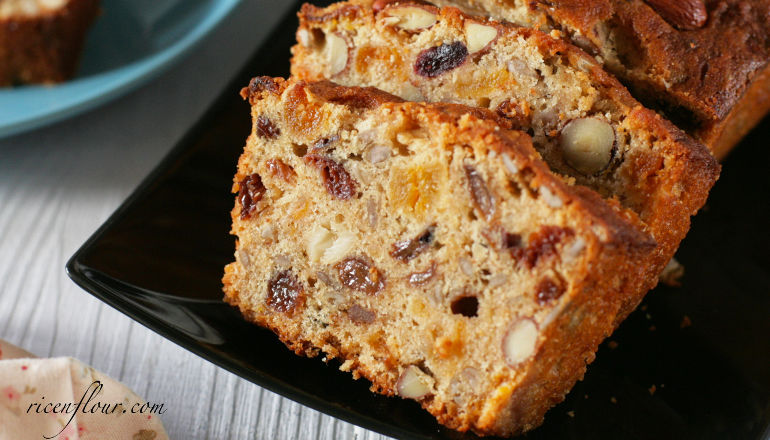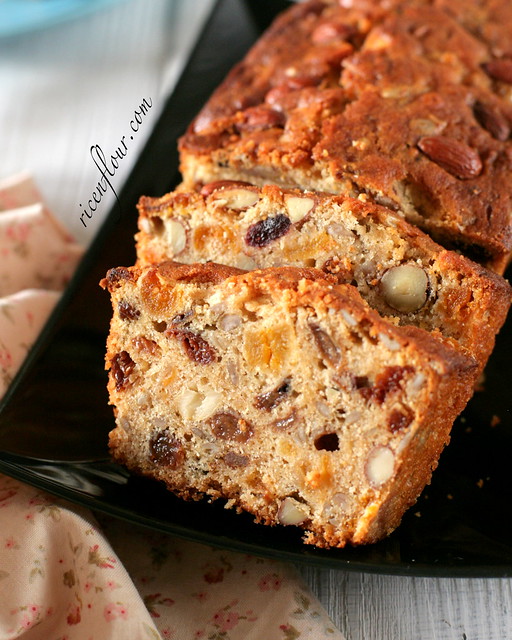As a special version of the traditional fruit cake, this Xmas fruit cake is alluring not only for its buttery, soft, melt-in-the-mouth texture, but also for the wonderfully ardent aroma derived from the combination of ginger, cinnamon, fruits mixed with alcohol – a perfect fit for cold winter.
For me, this Xmas fruit cake is always a “valuable” treat, both literally and figuratively. How could it not be valuable, when the entire progress includes not just mixing the batter and baking, but also several hours of macerating dried fruits, cubing them, roasting nuts… then a lengthy two-to-four-week period of regularly feeding the cake with alcohol, all for the cake to mature at its perfect state by Christmas.
For this value, the Xmas fruit cake always fulfills the purpose of being my precious Christmas gift to my most beloved ones. It’s simply a loaf of cake, but I believe any recipients would deeply perceive the love and sincerity put in all the efforts with all our heart.

* EQUIPMENT: one 25 cm loaf pan or 20 cm round baking pan
* INGREDIENTS
- 270 gram (2 cups plus 1.5 tablespoon) all purpose flour
- 12 gram (2-1/4 teaspoons) baking powder
- 3 gram (1 teaspoon) cinnamon powder
- 3 gram (1 teaspoon) ginger powder
- 220 gram (1 cup) unsalted butter – at room temperature
- A pinch of salt
- 50 gram (1/4 cup) caster sugar
- 80 gram (1/3 cup plus 1 tablespoon) brown sugar
- 3 medium size eggs (60 gram each including shells) – at room temperature
- Zest from 2 lemons or 1 orange – finely grate
- 3 ml (1/2 teaspoon) vanilla extract
- 3 ml (1/2 teaspoon) almond extract
- 60 ml (1/4 cup) milk – at room temperature
- 135 gram (1/2 cup plus 1 tablespoon) sugar-free yogurt – at room temperature
- 200 ~ 250 gram (8~9 oz.) dried nuts (hazelnut, walnut, pecan, almond…)
- 300 ~ 350 gram (9~10 oz.) dried fruits (grape, apricot, plum, cherry, orange peel…)
- 200 ~ 300 ml (approx. 1 cup) Brandy, Cognac or Rum
* Note about ingredients:
– The Xmas Fruit Cake is basically a butter cake with the addition of dried fruits, nuts and some other spices. So, in addition to the main butter cake component, you can absolutely be versatile with the fruits, nuts and spices to your own taste and preference.
– In the recipe above, the ingredients written in bold are compulsory. Instead of the traditional Pound cake recipe, I used a Butter cake recipe for a rich, buttery texture, yet still moist and melt-in-the-mouth enough, rather than the Pound cake’s dry, compact texture. The yogurt gives the cake a richer flavor, therefore should not be replaced with milk.
The ingredients in Italics are substitutable:
– Sugar: I used a combination of brown and caster sugar to achieve a yellowish brown color for the cake, but not too brown. With the amount of sugar indicated in this recipe, the cake is not excessively sweet to my taste. However, different types of sugar may have varying levels of sweetness, so you can adjust the sugar amount accordingly. If you all brown sugar, then you should increase the amount by about 1/3 (of the total amount) because white sugar is considerably sweeter than brown sugar.
– Ginger powder, cinnamon powder, vanilla extract and almond powder give the cake its complex, warm and rich flavor as well as aroma. Try to get all of them if you can. Orange/ lemon zest can be substituted by orange/ citrus flavor.
– Dried nuts and fruits can be any type you like or have access to. Other than those specified in the recipe, other options are pistachios (unsalted), pumpkin seeds, melon seeds… Those with higher oil content generally make the cake more tasty. As for dried fruits, choose those of varying colors with a mix of sweet and sour flavors.
– The alcohol used for this cake usually is dark spirits. Most recipes ask for Brandy or Cognac. I used Rum, which I think was pretty good. If there will be children eating your cake, then you can either omit the alcohol, or substitute it with Rum-flavored baking emulsion (I have one bottle, its odor is amazing, and it’s completely alcohol-free).
This recipe has a video tutorial and has been uploaded on my YouTube Channel (Savoury Days Kitchen). If you can’t play the video on this site, you can watch it directly on YouTube via this link.
Note: the video is in HD setting and has English subtitle, please press CC to activate it.
Printable recipe:
1. Macerating dried fruits:
– If your dried fruits are bigger fruits (such as apricots, plums, or cherries), then slice them into small cubes. Place them all in a bowl, pour alcohol until the fruits are completely submerged (I used about 250 ml). Seal airtight with cling film. Place the bowl in the fridge for 12 – 48 hours (depending on how early you start preparing – I let mine rest for 18 hours).
– After the fruits are done macerating, tip the mixture into a strainer with another bowl underneath to catch the liquor. This liquor has now absorbed the fruitfully delicious taste and smell from the fruits, which will later come in use for our cake. Set the fruits aside to dry completely.
2. Preparing the nuts:
– Set oven at 160°C (320°F), both top and bottom heat.
– Chop the dried nuts if they are too big, but the pieces shouldn’t be too small (you should be able to feel the nuts as you chew on them). Scatter the nuts on a baking tray, place in 160°C preheated oven, roast for about 5 – 7 minutes.
This step deepens the nuts’ flavor but: keep an eye on the nuts as you roast them because each oven heats differently, be careful not to burn them.
3. Grease the baking pan with cooking spray or by rubbing butter on the inside of the pan, then coat it with flour. Flip the pan over to get rid of excess flour.
4. Sift flour, baking powder, cinnamon powder and ginger powder (if you have them) into a bowl. Whisk until combined.
5. With a mixer, cream butter with salt for 15 – 30 seconds at medium speed until butter is softened. While keeping the mixer on, slowly sift of sprinkle sugar into the bowl (it takes about 30 seconds to sift all of the sugar). Or divide the sugar into 3 portions and sift one by one into the bowl, whisk each portion for 10 – 15 seconds to combine. Continue creaming butter with sugar until light and fluffy (depending on the mixer’s speed, it can take between 5 – 10 minutes). Turn off the mixer every so often to scrape the butter off the sides of the bowl.
6. Smash eggs one by one into the bowl and whisk with butter. Only whisk in the next egg once the last one has combined completely into the mixture. Add orange/lemon zest, vanilla extracts and other flavorings, mix well. Make sure to scrape the sides and bottom of the bowl periodically while mixing.
7. Combine milk and yogurt in a different bowl. Divide the flour mixture into 4 portions, milk into 3. Sift the first 1/4 of the flour into the butter mixture, mix well on lowest speed. Next, add in 1/3 milk, combine. Continue adding flour and milk alternately until the last milk portion has been added to the batter, and you have 1/4 flour remained.
8. Mix dried fruits with the remaining 1/4 flour portion, then transfer to the batter. Add nuts, mix gently with a whisk. The best mixing method at this point is folding. Note: As you mix flour into the batter in step (8) and (9), it is important not to overmix. An overmixed batter will result in a heavy, compact cake.
Scrape batter into baking pan, even out the surface with a wooden spoon or spatula. Bake at 160°C for about 50 – 55 minutes, then lower oven to 150°C and continue baking for 10 – 15 minutes. At this point, the cake is mostly done, it’s golden brown, well-risen with a cracked surface. A skewer inserted into the cake center should come out clean and dry. If the cake top turns brown too quickly after 1/2 – 2/3 of the baking duration, cover the cake with a piece of aluminum foil to avoid burning.
9. Take the cake out of the oven, let cool for about 10 minutes. The cake will slightly shrink and the sides will start to pull away from the pan. Take the cake out of the pan. Liberally brush the top and sides of the cake with alcohol. Repeat another 2 – 3 times until the cake is cooled.
10. A well-done cake produces the most amazing combined smell of butter, roasted nuts and other aroma spices and flavorings, such as ginger, cinnamon, almond, orange… The cake texture is soft and moist, there is absolutely no denseness or stickiness. It has moderate sweetness, blended with rich flavors from fruits and nuts.
11. The Xmas Fruit Cake usually is made 3 – 4 weeks in advance, then refrigerated and fed with alcohol 2 – 3 times per week to build the perfectly alcohol-enriched, soft and moist state by the time of Christmas. However, this recipe gives a really soft and fluffy cake already, which can absolutely be feasted on right after it’s been made. I have tried with both versions: 4 weeks with alcohol at least twice per week and only one time of brushing alcohol right after baked. Both were great.
* Notes:
– If you would like to keep the cake for weeks to feed it more heavily with alcohol, then I suggest to bake it for about 15 – 20 minutes longer so it becomes drier. Then repeatedly brush the cake with alcohol 2 – 3 times per week. How much alcohol used and how many times you feed it entirely depends on how heavily alcoholic smelling you want your cake to be.
– If you don’t want to use alcohol, you can soak the dried fruits in warm water for 1 – 2 hours until they are softer, then drain and mix them with the cake batter. After the cake is well baked, you can brush it with apricot jam or honey mixed with some lukewarm orange juice. The cake will be just as aromatic and glossy.
– If you don’t brush the cake with alcohol at all, it can be stored in the refrigerator for 3 – 4 days. Before serving, microwave the cake for about 20 – 30 seconds to make it softer and moister.





Linh Trang hello. I hardly bake. Must be 20 years ago was my last one.
Had the urge to do again because of m son’s birthday. Tried and I got good and encouraging comment from families and friends.
I am baking again tomorrow.
Thanks for your superb recipe